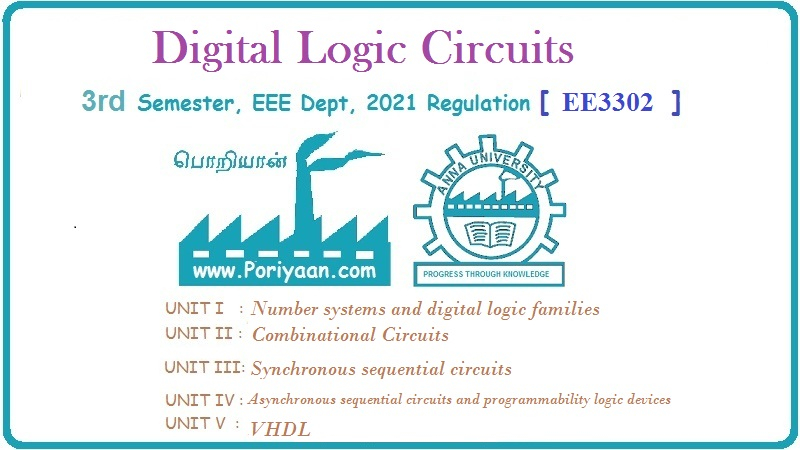Digital Logic Circuits: Unit IV: (a) Asynchronous Sequential Circuits
Two Marks Questions with Answers
Asynchronous Sequential Circuits | Digital Logic Circuits
Digital Logic Circuits: Unit IV: (a) Asynchronous Sequential Circuits : Two Marks Questions with Answers
Two Marks Questions with Answers
Q.1
What is an asynchronous sequential circuit ?
AU
: Dec.-04
Ans.
:
The sequential circuits in which the change in input signals can affect memory
element at any instant of time are called asynchronous sequential circuits.
Q.2
How does the operation of an asynchronous input differ from that of a
synchronous input ?
Ans.
:
In synchronous sequential circuits, memory elements are clocked flip-flops.
Hence input signals can affect the memory elements only at discrete instants of
time.
In
asynchronous sequential circuits, memory elements are either unclocked
flip-flops or time delay elements. Therefore in asynchronous sequential
circuits change in input signals can affect memory element at any instant of
time.
Q.3
What are the types of asynchronous circuits ?
AU
: May-16
Ans.
: 1. Fundamental mode circuits
2.
Pulse mode circuits.
Q.4
What is a fundamental mode asynchronous sequential circuit ?
AU
: Dec.-03, 11
Ans.
:
According to how input variables are to be considered, fundamental mode circuit
assumes that :
•
The input variables change only when the circuit is stable.
•
Only one input variable can change at a given time and
•
Inputs are levels and not pulses.
Q.5
What is pulse mode circuit ? (Refer section 7.2)
Q.6
Define secondary uariables and excitation variables.
Ans.
:
The present state and next state variables in asynchronous sequential circuits
are called secondary variables and excitation variables, respectively.
Q.7
Define flow table in asynchronous sequential circuit.
AU
: May-12
Ans.
:
During the design of asynchronous sequential circuits, it is more convenient to
name the states by letter symbols without making specific reference to their
binary values. Such a table is called a flow table.
Q.8
What is the difference between flow table and transition table ?
AU
: May-13
Ans.
:
The difference between flow table and transition table is that the internal
states in flow table are symbolized with letters whereas internal states in
transition table are represented by binary numbers.
Q.9
Define primitive flow table.
Ans.
:
It is defined as a flow table which has exactly one stable state for each row
in the table. The design process begins with the construction of primitive flow
table.
Q.10
What are the steps for the design of asynchronous sequential circuit ?
(Refer
sections 7.4 and 7.6)
Q.11
Define merger graph.
Ans.
:
The merger graph is defined as follows. It contains the same number of vertices
as the state table contains states. A line drawn between the two state vertices
indicates each compatible state pair. If two states are incompatible no
connecting line is drawn. It is used as a tool in state reduction process.
Q.12
What is a cycle ? OR When does a cycle occur ?
Ans.
:
A cycle occurs when an asynchronous circuit makes a transition through a series
of unstable states. The cycle does not contain a stable state, the circuit will
go from one unstable to stable to another, until the inputs are changed.
Q.13
What are races ? OR What is race condition in an asynchronous sequential
circuit ?
AU
: Dec.-12, 16, May-13
Ans.
:
When two or more binary state variables change their value in response to a change
in an input variable, race condition occurs in an asynchronous sequential
circuit. In case of unequal delays, a race condition may cause the state
variables to change in an unpredictable manner.
Q.14
Define non critical race.
Ans.
:
If the final stable state that the circuit reaches does not depend on the order
in which the state variable changes, the race condition is not harmful and it
is called a non critical race.
Q.15
Define critical race.
Ans.
:
If the final stable state depends on the order in which the state variable
changes, the race condition is harmful and it is called a critical race.
Q.16
What are the significance of state assignment ?
Ans.
:
In synchronous drcuits-state assignments are made with the objective of circuit
reduction. In asynchronous circuits its objective is to avoid critical races.
Q.17
What are the different techniques used in state assignment ?
Ans.
:
1.
Shared row state assignment
2.
One hot state assignment.
Q.18
What are the drawbacks in designing asynchronous sequential machines ?
Ans.
:
Asynchronous circuit responds to all the transient values and problems like
oscillations, critical race and hazards. So asynchronous circuits are difficult
to design.
Q.19
Compare pulsed mode and fundamental mode asynchronous circuit.
(Refer
section 7.2)
Q.20
What is a flow table ? Give example.
(Refer
section 7.6.1)
Q.21
Draw the block diagram of asynchronous sequential circuit.
(Refer
section 7.2)
Digital Logic Circuits: Unit IV: (a) Asynchronous Sequential Circuits : Tag: : Asynchronous Sequential Circuits | Digital Logic Circuits - Two Marks Questions with Answers
Related Topics
Related Subjects
Digital Logic Circuits
EE3302 3rd Semester EEE Dept | 2021 Regulation | 3rd Semester EEE Dept 2021 Regulation
